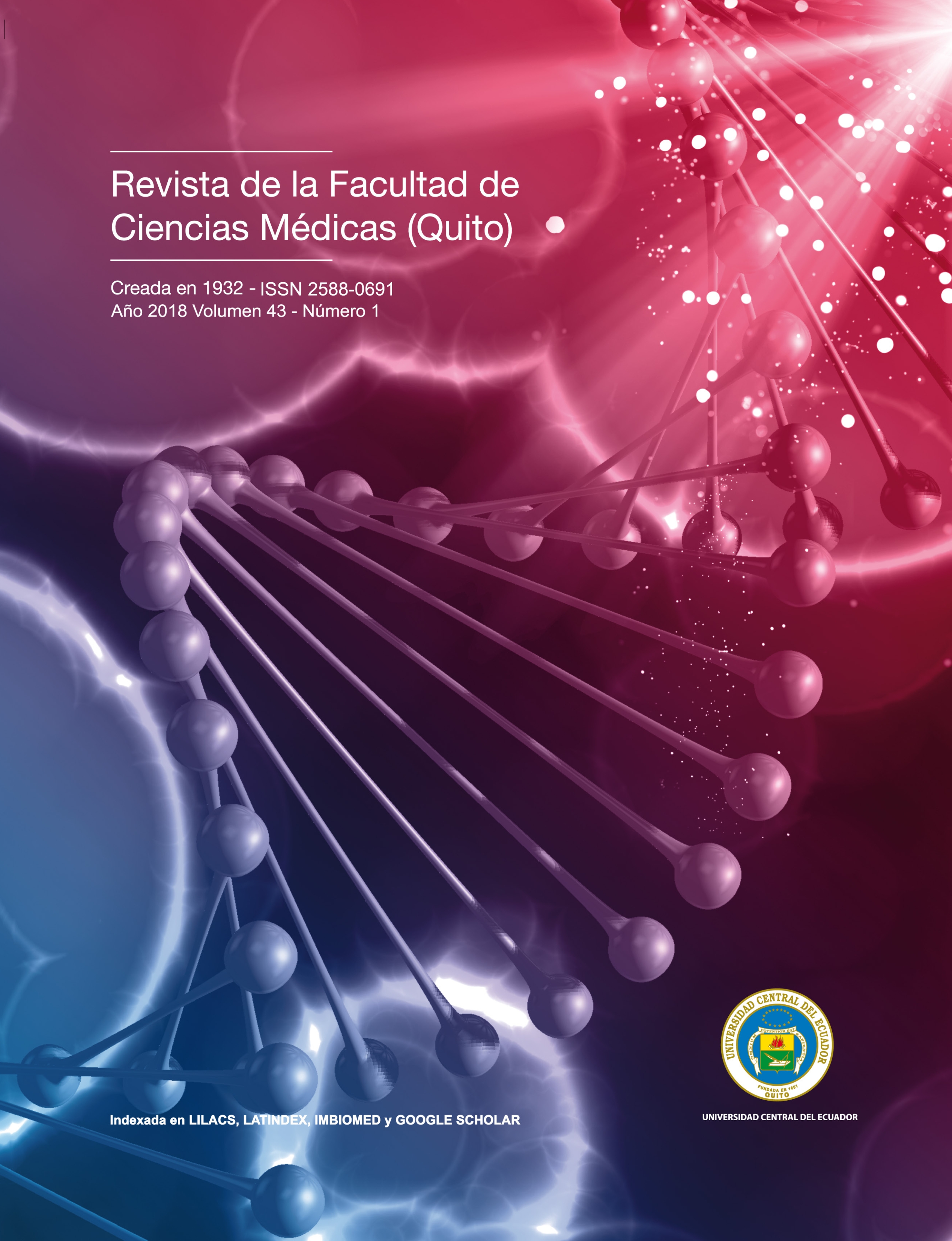Un vistazo a la investigación científica en la Facultad de Ciencias Médicas de la Universidad Central del Ecuador, entre 2014 y 2017
DOI:
https://doi.org/10.29166/ciencias_medicas.v43i1.1462Palabras clave:
Investigación científica, Educación médica, Salud, Grupos de investigación, Innovación, Desarrollo social, Conocimiento, EcuadorResumen
Contexto: se requiere la investigacion como un elemento clave para alcanzar el desarrollo y es la universidad la fuente mayor de esa investigacion. Además, es un indicador clave en la evaluación de la calidad universitaria. Material y métodos: se analizó la producción científica registrada en la base de datos Scopus, la presencia de grupos de investigación estructurados activos, los proyectos en ejecución y la participación en redes de cooperación y colaboración especializada.
Discusión: la investigación científica reflejada en la producción científica se ha incrementado en la con un repunte significativo en los últimos cuatro años; en paralelo, como una alternativa para diversificar la formación especializada.
Conclusión: entre el 2008 y 2017 se publicaron 362 artículos científicos en la FCM-UCE; existen 8 grupos activos de investigación exclusivos de la FCM; entre 2014 y 2017 se registraron 159 proyectos de investigación
Descargas
Métricas
Citas
Lipschutz A, Mostny G, Robin L, Santiana A. (1946) Blood Groups in Tribes of Tierra del Fuego and their Bearing on Ethnic and Genetic Relationships. Nature, 157 (3995): 696 – 697.
Naranjo P. (1958) Etiological agents of respiratory allergy in tropical countries of Central and South America. J Allergy, 29 (4): 362 – 374.
Vickery AL Jr, Fierro-Benitez R, Kakulas BA. (1966) Skeletal muscle structure in endemic cretinism. Am J Pathol. 49 (1): 193 – 201.
Fierro-Benitez R, Stanbury J B, Querido A, Degroot L, Alban R, Cordova J. (1970) Endemic Cretinism in the Andean Region of Ecuador. The Journal of Clinical Endocrinology & Metabolism, 30 (2):228–236.
Lovato R, Guevara A, Guderian R, Proaño R, Unnasch T, Criollo H, Hassan HK, Mackenzie CD. (2014) Interruption of infection transmission in the onchocerciasis focus of Ecuador leading to the cessation of ivermectin distribution. PLoS Negl Trop Dis.;8(5):e2821.
Sempértegui F, Estrella B, Rodríguez O, Gómez D, Cabezas M, Salgado G, Sabin LL, Hamer DH. (2014) Zinc as an adjunct to the treatment of severe pneumonia in Ecuadorian children: a randomized controlled trial. Am J Clin Nutr.;99(3):497-505.
Baldeón, L.R., Weigelt, K., De Wit, H., Ozcan B, van Oudenaren A, Sempértegui F, Sijbrands E, Grosse L, Freire W, Drexhage, H.A., Leenen, P.J.M. (2014). Decreased serum level of miR-146a as sign of chronic inflammation in type 2 diabetic patients. PLoS ONE. 9(12), e115209.
Santangelo R, González-Andrade F, Børsting C, Torroni A, Pereira V, Morling N.Analysis of ancestry informative markers in three main ethnic groups from Ecuador supports a trihybrid origin of Ecuadorians. (2017). Forensic Sci Int Genet.;31:29-33.
López-Pulles R, Chiriboga M, Carrera A. (2017) The Present Situation of e-Health and mHealth in Ecuador. Latin Am J telehealth, Belo Horizonte; 4 (3): 261 – 267
https://www.scopus.com/term/analyzer.uri?sid=e0e63eb9b831c598e43a468fc84984a6&origin=resultslist&src=s&s=%28AFID%28%22Central+University+of+Ecuador%22+60072038%29+%29&sort=plff&sdt=afsp&sot=afnl&sl=50&count=510&analyzeResults=Analyze+results&txGid=89b001f2bf9f9572c-4d19df9b8d7cc19 (Consultado el 12 de abril de 2018).
Universidad Central del Ecuador. (2018) Informe de Gestión 2017. Suplemento institucional. 13 de abril de 2018. p. 8
https://www.scopus.com/term/analyzer.uri?sid=590780da3e0c2a392674b3c56cad93db&origin=resultslist&src=s&s=%28AF-ID%28%22Central+University+of+Ecuador%22+60072038%29+%29&sort=plf-f&sdt=afsp&sot=afnl&sl=50&count=512&analyzeResults=Analyze+results&txGid=38f5783bfce72a38ce763aee7b326a15 (Consultado el 19 de abril de 2018)
https://enfoquecientifico.com/2018/04/17/ensayo-6/ (Consultado el 17 de abril de 2018).
Uzcanga G, Lara E, Gutiérrez F, Beaty D, Beske T, Teran R, Navarro JC, Pasero P, Benítez W, Poveda A. (2017) Nuclear DNA replication and repair in parasites of the genus Leishmania: Exploiting differences to develop innovative therapeutic approaches. Crit Rev Microbiol.; 43(2):156-177.
Alda P, Lounnas M, Vázquez AA, Ayaqui R, Calvopiña M, Celi-Erazo M, Dillon RT Jr., Jarne P, Loker ES, Muñiz Pareja FC, Muzzio-Aroca J, Nárvaez AO, Noya O, Robles LM, Rodríguez-Hidalgo R, Uribe N,David P, Pointier JP, Hurtrez-Boussès S. (2018) A new multiplex PCR assay to distinguish among three cryptic Galba species, intermediate hosts of Fasciola hepatica. Vet Parasitol.; 251:101-105.
Cevallos W, Fernández-Soto P, Calvopiña M, Buendía-Sánchez M, López-Abán J, Vicente B, Muro A. (2018) Diagnosis of amphimeriasis by LAMPhimerus assay in human stool samples long-term storage onto filter paper. PLoS One.; 13(2):e0192637.
Vinueza-Burgos C, Cevallos M, Cineros M, Van-Damme M y De Zutter L. (2018) Quantification of the Campylobacter contamination on broiler carcasses during the slaughter of Campylobacterpositive flocks in semi-industrialized slaughterhouses. International Journal of Food Microbiology; 269: 75-79.Estévez
Dumonteil E, Herrera C, Martini L, Grijalva MJ, Guevara AG, Costales JA, Aguilar HM, Brenière SF, Waleckx E. (2016) Chagas Disease Has Not Been Controlled in Ecuador. PLoS One.;11(6):e0158145










